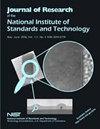X-ray Computed Tomography Instrument Performance Evaluation, Part I: Sensitivity to Detector Geometry Errors.
IF 1.3
4区 工程技术
Q3 INSTRUMENTS & INSTRUMENTATION
Journal of Research of the National Institute of Standards and Technology
Pub Date : 2019-07-11
DOI:10.1002/HTTPS://DOI.ORG/10.6028/JRES.124.014
引用次数: 13
Abstract
X-ray computed tomography (XCT), long used in medical imaging and defect inspection, is now increasingly used for dimensional measurements of geometrical features in engineering components. With widespread use of XCT instruments, there is growing need for the development of standardized test procedures to verify manufacturer specifications and provide pathways to establish metrological traceability. As technical committees within the American Society of Mechanical Engineers (ASME) and the International Organization for Standardization (ISO) are developing documentary standards that include test procedures that are sensitive to all known error sources, we report on work exploring one set of error sources, instrument geometry errors, and their effect on dimensional measurements. In particular, we studied detector and rotation stage errors in cone-beam XCT instruments and determined their influence on sphere center-to-center distance errors and sphere form errors for spheres located in the tomographically reconstructed measurement volume. We developed a novel method, called the single-point ray tracing method, that allows for efficient determination of the sphere center-to-center distance error and sphere form error in the presence of each of the different geometry errors in an XCT instrument. In Part I of this work, we (1) describe the single-point ray tracing method, (2) discuss optimal placement of spheres so that sphere center-to-center distance errors and sphere form errors are sensitive to the different detector geometry errors, and (3) present data validating our method against the more conventional radiograph-based tomographic reconstruction method. In Part II of this work, we discuss optimal placement of spheres so that sphere center-to-center distance errors and sphere form errors are sensitive to error sources associated with the rotation stage. This work is in support of ongoing standards development activity within ASME and ISO for XCT performance evaluation.X射线计算机断层扫描仪器性能评估,第一部分:对探测器几何误差的敏感性。
x射线计算机断层扫描(XCT)长期用于医学成像和缺陷检测,现在越来越多地用于工程部件几何特征的尺寸测量。随着XCT仪器的广泛使用,越来越需要开发标准化的测试程序来验证制造商的规格,并提供建立计量可追溯性的途径。由于美国机械工程师协会(ASME)和国际标准化组织(ISO)的技术委员会正在制定文件标准,其中包括对所有已知误差源敏感的测试程序,我们报告了探索一组误差源,仪器几何误差及其对尺寸测量的影响的工作。特别地,我们研究了锥束XCT仪器中的探测器和旋转级误差,并确定了它们对层析重建测量体中球体中心到中心距离误差和球体形状误差的影响。我们开发了一种新的方法,称为单点射线追踪法,可以有效地确定XCT仪器中存在不同几何误差的球体中心到中心距离误差和球体形状误差。在本工作的第一部分中,我们(1)描述了单点射线追踪方法,(2)讨论了球体的最佳放置,以便球体中心到中心距离误差和球体形状误差对不同的探测器几何误差敏感,以及(3)提供数据验证我们的方法与更传统的基于射线摄影的层析重建方法。在本工作的第二部分中,我们讨论了球体的最佳放置,使球体中心到中心距离误差和球体形状误差对与旋转阶段相关的误差源敏感。这项工作是为了支持ASME和ISO对XCT性能评估的持续标准开发活动。
本文章由计算机程序翻译,如有差异,请以英文原文为准。
求助全文
约1分钟内获得全文
求助全文
来源期刊
自引率
33.30%
发文量
10
审稿时长
>12 weeks
期刊介绍:
The Journal of Research of the National Institute of Standards and Technology is the flagship publication of the National Institute of Standards and Technology. It has been published under various titles and forms since 1904, with its roots as Scientific Papers issued as the Bulletin of the Bureau of Standards.
In 1928, the Scientific Papers were combined with Technologic Papers, which reported results of investigations of material and methods of testing. This new publication was titled the Bureau of Standards Journal of Research.
The Journal of Research of NIST reports NIST research and development in metrology and related fields of physical science, engineering, applied mathematics, statistics, biotechnology, information technology.

 求助内容:
求助内容: 应助结果提醒方式:
应助结果提醒方式:


